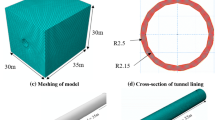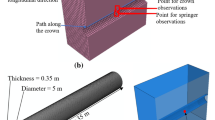Abstract
The present study deals with three-dimensional nonlinear finite element (FE) analyses of a tunnel in rock with reinforced concrete (RC) lining subjected to internal blast loading. The analyses have been performed using the coupled Eulerian–Lagrangian analysis tool available in FE software Abaqus/Explicit. Rock and RC lining are modeled using three-dimensional Lagrangian elements. Beam elements have been used to model reinforcement in RC lining. Three different rock types with different weathering conditions have been used to understand the response of rock when subjected to blast load. The trinitrotoluene (TNT) explosive and surrounding air have been modeled using the Eulerian elements. The Drucker–Prager plasticity model with strain rate-dependent material properties has been used to simulate the stress–strain response of rock. The concrete damaged plasticity model and Johnson–Cook plasticity model have been used for the simulation of stress–strain response of concrete and steel, respectively. The explosive (TNT) has been modeled using Jones–Wilkins–Lee (JWL) equation of state. The analysis results have been studied for stresses, deformation and damage of RC lining and the surrounding rock. It is observed that damage in RC lining results in higher stress in rock. Rocks with low modulus and high weathering conditions show higher attenuation of shock wave. Higher amount of ground shock wave propagation is observed in case of less weathered rock. Ground heave is observed under blast loading for tunnel close to ground surface.




















Similar content being viewed by others
Abbreviations
- ϕ :
-
Angle of internal friction
- \(\psi\) :
-
Dilation angle at mean stress–deviatoric stress plane
- \(\varepsilon\) :
-
Eccentricity parameter
- \(\varepsilon^{ * }\) :
-
Dimensionless plastic strain
- \(\dot{\varepsilon }\) :
-
Strain rate
- \(\dot{\varepsilon }_{0}\) :
-
Reference strain rate
- \(\varepsilon_{\text{t}}^{\text{pl}}\) :
-
Tensile plastic strain
- \(\varepsilon_{\text{c}}^{\text{pl}}\) :
-
Compressive plastic strain
- ν :
-
Poisson’s ratio
- \(\rho_{\text{c}}\) :
-
Density of concrete
- \(\rho_{\text{s}}\) :
-
Density of steel
- \(\rho\) :
-
Current density
- \(\bar{\rho }\) :
-
Ratio of density of explosive in the solid state to current density
- \(\rho_{\text{sol}}\) :
-
Density of explosive in the solid state
- β :
-
Parameter related to the angle of internal friction
- \(\sigma\) :
-
Dynamic yield stress (J–C) model
- \(\sigma_{\text{t}}\) :
-
Tensile stress
- \(\sigma_{\text{c}}\) :
-
Compressive stress
- \(\hat{\bar{\sigma }}_{\hbox{max} }\) :
-
Maximum principal effective stress
- \(\sigma_{\text{b0}}\) :
-
Initial equibiaxial compressive yield stress
- \(\sigma_{\text{c0}}\) :
-
Initial uniaxial compressive yield stress
- \(\sigma_{\text{t0}}\) :
-
Uniaxial tensile stress at failure
- \(\sigma_{1}\), \(\sigma_{2}\), \(\sigma_{3}\) :
-
Effective stress in x, y and z directions, respectively
- A, B :
-
Magnitude of pressure (JWL EOS)
- A, B, C, m, n :
-
Model parameters (J–C) model
- c :
-
Cohesion
- c v :
-
Speed of sound wave
- d :
-
Hardening parameter
- \(d_{\text{t}}\) :
-
Damage variable for tension
- \(d_{\text{c}}\) :
-
Damage variable for compression
- \(D_{\text{o}}^{\text{el}}\) :
-
Undamaged initial elastic modulus
- E c :
-
Modulus of elasticity of concrete
- E s :
-
Modulus of elasticity of steel
- e int :
-
Specific internal energy at atmospheric pressure
- f ck :
-
Compressive strength of concrete
- f s :
-
Tensile yield strength
- G p :
-
Plastic potential function
- l :
-
Smallest element dimension
- K :
-
Scalar parameter
- K c :
-
Ratio of second deviatoric stress invariant on the tensile meridian to that on the compressive meridian at initial crushing for any given value of effective mean stress
- p :
-
Pressure
- \(\bar{p}\) :
-
Effective mean pressure
- p′:
-
Mean stress
- q :
-
Deviatoric stress
- R 1, R 2, ω :
-
Material constants (JWL EOS)
- r :
-
Third invariant of the deviatoric stress tensor
- \(\bar{s}\) :
-
Deviatoric stress tensor
- T*:
-
Homologous temperature
- Δt :
-
Time increment
- \(t_{w}\) :
-
Thickness of concrete lining
- U :
-
Displacement perpendicular to plane
- \(U_{\text{R}}\) :
-
Out-of-plane rotations
- x, y, z :
-
Cartesian directions
- W :
-
Charge weight
References
Abaqus/Explicit User’s Manual, version 6.11 (2011) Dassault Systèmes Simulia Corporation, Providence
Al-Rub RKA, Kim SM (2010) Computational applications of a coupled plasticity-damage constitutive model for simulating plain concrete fracture. Eng Fract Mech 77:1577–1603
Babanouri N, Mansouri H, Nasab SK, Bahaadini M (2013) A coupled method of study blast wave propagation in fractured rock masses and estimate unknown properties. Comput Geotech 49:134–142
Berta G (1994) Blasting-induced vibration in tunneling. Tunn Undergr Space Technol 9(2):175–187
Bischoff PH, Perry SH (1991) Compressive behavior of concrete at high strain rates. Mater Struct 24:425–450
Carreira DJ, Chu K (1985) Stress strain relationship for plain concrete in compression. ACI J 82(6):797–804
Carreira DJ, Chu K (1986) Stress strain relationship for reinforced concrete in tension. ACI J 83(1):21–28
Chakraborty T, Larcher M, Gebbeken N (2013) Comparative performance of tunnel lining materials under blast loading. In: Proceedings of 3rd international conference on computational methods in tunneling and subsurface engineering, Ruhr University Bochum, Germany, 17–19 Apr 2013
Chille F, Sala A, Casadei F (1998) Containment of blast phenomena in underground electrical power plants. Adv Eng Softw 29(1):7–12
Design specifications (2015) Delhi Metro Rail Corporation Limited, Barakhamba road, New Delhi, India
Dowing CH (1996) Construction vibrations. Prentice-Hall Englewood Cliffs Comite Euro-International du Beton. CEB-FIP model code 1990, Redwood Books, Trowbridge
Du H, Li Z (2009) Numerical analysis of dynamic behavior of RC slabs under blast loading. Trans Tianjin Univ 15(1):61–64
Dusenberry DO (2010) Handbook for blast resistant design of buildings, 1st edn. Wiley, Hoboken
Eitzenberger A (2012) Wave propagation in rock and the influence of discontinuities. Doctoral thesis, Luleal University of Technology, Sweden
Goel MD, Matsagar VA, Gupta AK, Marburg S (2012) An abridged review of blast wave parameters. Def Sci J 62(5):300–306
Guldemeister N, Durr N, Wunnemann K, Elbeshausen D, Hiermaier S (2011) Propagation of impact-induced shock waves in heterogeneous rocks using mesoscale modeling. In: 42nd lunar and planetary science conference, The Woodlands Texas, 7–11 Mar 2011
Johnson GR, Cook WH (1983) A constitutive model and data for metals subjected to large strains, high strain rates and high temperatures. In: Proceedings of 7th international symposium on ballistics, Hague, Netherlands, 19–21 Apr 1983, pp 541–547
Larcher M, Casadei F (2010) Explosions in complex geometries—comparison of several approaches. European Commission, Joint Research Centre, Institute for Protection and Security of the Citizen, Italy
Lee J, Fenves GL (1998) Plastic damage model for cyclic loading of concrete structures. J Eng Mech 124(8):892–900
Lee JH, Salgado R (1999) Determination of pile base resistance in sands. J Geotech Geoenviron Eng ASCE 125(8):673–683
Liang Q, Li J, Li D, Qu E (2013) Effect of blast-induced vibration from new railway tunnel on existing adjacent railway tunnel in Xinjiang, China. Rock Mech Rock Eng 46(1):19–39
Liu H (2009) Dynamic analysis of subway structures under blast loading. Geotech Geolog Eng ASCE 27(6):699–711
Liu C, Ahrens TJ (1997) Stress wave attenuation in shock-damaged rock. J Geophys Res 102(B3):5243–5250
Lubliner J, Oliver J, Oller S, Onate E (1989) A plastic damage model for concrete. Int J Solids Struct 25(3):299–329
Ma GW, Hao H, Zhou YX (1998) Modeling of wave propagation induced by underground explosion. Comput Geotech 22(3–4):283–303
Ngo T, Mendis P, Gupta A, Ramsay J (2007) Blast loading and blast effects on structures—an overview. Electron J Struct Eng 76–91 (special issue: loading on structures)
UFC 03-340-02 (2008) Structures to resist the effects of accidental explosions. Unified Facilities Criteria, US Departments of Army and Navy and Air Force, USA
Wu YK, Hao H, Zhou YX, Chong K (1998) Propagation characteristics of blast induced shock waves in a jointed rock mass. Soil Dyn Earthq Eng 17(6):407–412
Yadav HR (2005) Geotechnical evaluation and analysis of Delhi metro tunnels. Doctoral thesis, Indian Institute of Technology (IIT) Delhi, New Delhi, India
Zhao CF, Chen JY (2013) Damage mechanics and mode of square reinforced concrete slab subjected to blast loading. Theor Appl Fract Mech 63–64:54–62
Zhao XQ, Hao H (2008) Modeling of compressive behavior of concrete like materials at high strain rates. Int J Solids Struct 45(17):4648–4661
Zhou Y, Zhao J (2011) Advances in rock dynamics and applications. Taylor and Francis, London
Author information
Authors and Affiliations
Corresponding author
Rights and permissions
About this article
Cite this article
Tiwari, R., Chakraborty, T. & Matsagar, V. Dynamic Analysis of Tunnel in Weathered Rock Subjected to Internal Blast Loading. Rock Mech Rock Eng 49, 4441–4458 (2016). https://doi.org/10.1007/s00603-016-1043-8
Received:
Accepted:
Published:
Issue Date:
DOI: https://doi.org/10.1007/s00603-016-1043-8




